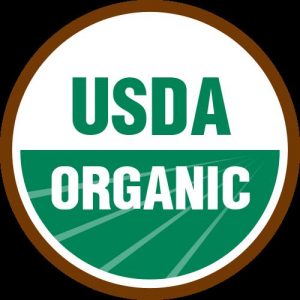USDA Organic: What Are The Standards Behind The Symbol?
 A growing number of today’s consumers are shopping for organic foods and look for the USDA Organic Seal on food packaging to ensure the product is organically grown.
A growing number of today’s consumers are shopping for organic foods and look for the USDA Organic Seal on food packaging to ensure the product is organically grown.
So, what are the standards behind the symbol?
USDA Organic: What It Means
The USDA (U.S. Dept. of Agriculture) defines organic agriculture as producing food products with methods that preserve our environment and “avoid most synthetic materials, such as pesticides and antibiotics.” The USDA organic standards regulate how farmers raise livestock, grow crops, and specify the materials that can be used.
The standards govern water and soil quality, livestock practices, pest control, and food additives. Organic growers and processors certified by the USDA must:
- support animal health and welfare.
- preserve biodiversity and natural resources.
- use only USDA approved materials.
- provide livestock outdoor access to enjoy their natural behaviors,
- have yearly onsite inspections.
- keep organic and non-organic food separate.
- not use genetically modified ingredients.
To carry the USDA organic seal, following the organic standards must be validated by a USDA accredited certifying agent.
The USDA seal also verifies specific standards for meat, plant, and multi-ingredient products:
- The organic seal on meat products guarantees the producers followed livestock health and welfare regulations, did not give the animals growth hormones or antibiotics, provided 100 percent organic feed, and gave the livestock outdoor access.
- The organic seal on crops or plant products assures that sewage sludge, irradiation, synthetic fertilizers, prohibited pesticides, and genetically modified organisms were not used in crop production.
- The organic seal on multi-ingredient foods verifies the item contains 95 percent (or more) certified organic content.
If you suspect an identified organic product does not meet the USDA standards, you may submit a complaint to the USDA—they claim to investigate all complaints.
The Reality of Shopping Organic
We need to be aware that in today’s food industry package labels can be deceptive. For instance, “organically raised” cows might have been fattened-up at a factory farm just before slaughtering. Organically fed chickens might have lived in crowded, unsanitary conditions.
The only way to know that the food you consume is 100 percent organic is to grow it yourself. The next best way to obtain pure organic food is to shop at trusted local organic markets or farm stands.
However, though organic food in grocery stores may contain some non-organic ingredients, evidence suggests a store-purchased organic diet is significantly more nutritious and pesticide free than a non-organic one. If a grocery store food product claims to be organic but does not carry the USDA organic seal, be suspicious and investigate before you buy.
Sources: Health Freedoms; usda.gov; ams.usda.gov
Photo Credit: U.S. Dept. of Agriculture / flickr
 Eating Disorder Self Test. Take the EAT-26 self test to see if you might have eating disorder symptoms that might require professional evaluation. All answers are confidential.
Eating Disorder Self Test. Take the EAT-26 self test to see if you might have eating disorder symptoms that might require professional evaluation. All answers are confidential.